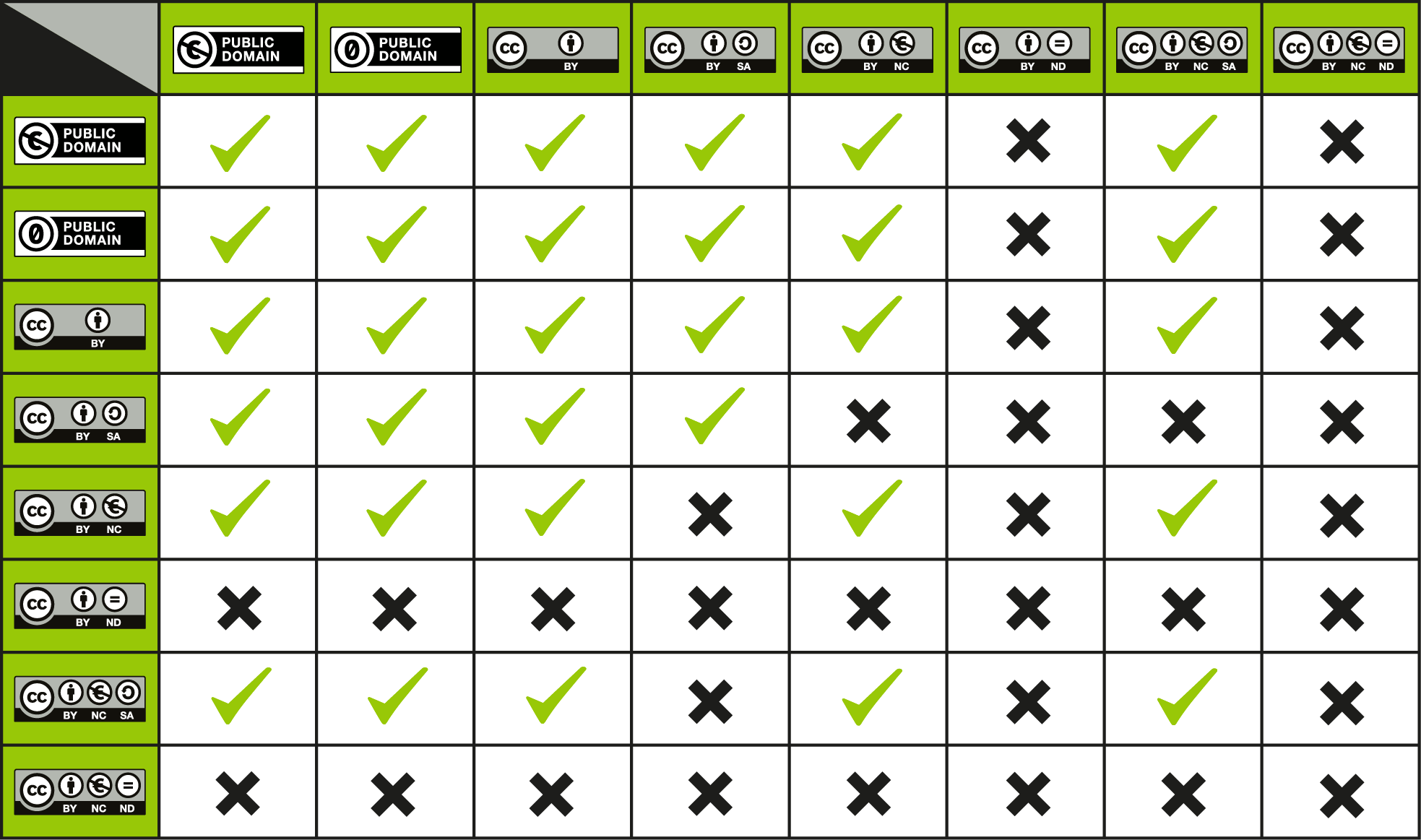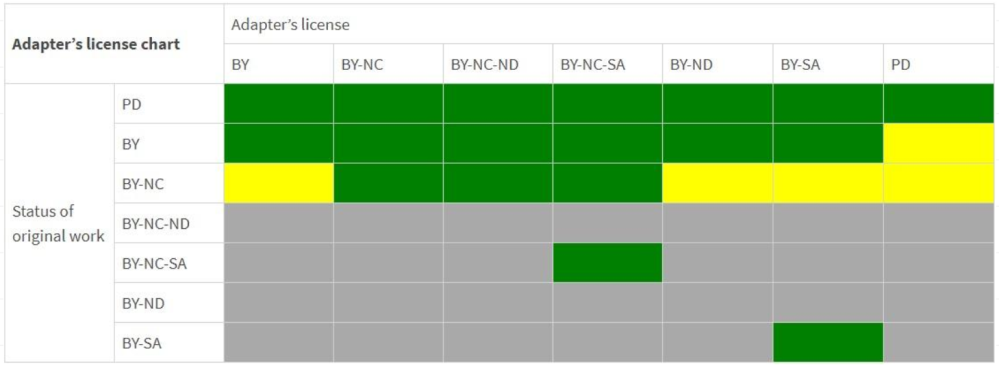By Chrystal Pickell Vandervest
Read time: 3 minutes
What’s that? You want to include other Creative Commons (CC) licensed works in your open educational resource (OER), too!? (You probably weren’t thinking that at all, but it’s what we’re talking about today.)
It’s quite common. And, if you’ve read an OER textbook, you’ve seen it in action.
Before you start developing (the brainstorming part), you’ll need to know about collections, remixes, and derivatives. And, you’ll need to know the best practices for using works in collections or remixing them into an OER.
Curating collections
Simply, a collection is a bunch of different works (as-is) put together in an organized way.1
Let’s think about this in terms of baking. Your baking ingredients that live in the cupboard (or fridge) are similar to creative works with CC licenses. Your flour, powdered sugar, brown sugar, and eggs are a collection. Even though you may move them to air-tight containers, you have only organized them.
Giving credit where credit is due
Each work in a collection has its own license.  And, you must have attribution included for each one. Don’t panic; it’s not a detailed citation.
And, you must have attribution included for each one. Don’t panic; it’s not a detailed citation.
The best practices for giving attributions follow TASL (not graduation tassels). To do this, you’ll need the:
- Title,
- Author,
- Source,
- and License.2
Now, you’ll want to license the whole collection with your own CC license. This license is ONLY for your contributions – selection and arrangement – not each included work.
Don’t worry if you’re confused (I was too). Swipe through the below example collection. And, you’ll notice 1.) that the whole collection is licensed by me (well, MCLS) and 2.) the attribution for each picture is right below it (in the TASL format).
So what are remixes and adaptations anyway?
Remixes and adaptations (aka derivatives) are a mix of different works that create a new work.1
We talked about collections being the baking ingredients in yo ur cupboard. Adaptations and remixes are like putting all these ingredients together in your (dusted off) KitchenAid mixer (mine’s blue), pouring it into your favorite 8×8 baking pan, and popping it into the oven. The smell of chocolate and brownie goodness fills your house (I might be hungry right now).
ur cupboard. Adaptations and remixes are like putting all these ingredients together in your (dusted off) KitchenAid mixer (mine’s blue), pouring it into your favorite 8×8 baking pan, and popping it into the oven. The smell of chocolate and brownie goodness fills your house (I might be hungry right now).
When those delicious triple-chocolate brownies come out of the oven cooked and ready for vanilla bean ice cream, you can’t tell where the flour, eggs, and other ingredients begin and end. They have become something completely new — brownies (not just any brownies, triple chocolate)!
And, this is exactly what happens in an OER textbook. You see the references and footnotes throughout, but the author has mixed works together to create a new OER. It’s hard to see where each sourced material begins and ends and even what changes or additions were made to it.
What ‘ingredients’ can you mix together?
I think we can both agree that you wouldn’t put bananas in your brownies. (Right?) It’s the same with your OER. Some CC-licensed works shouldn’t be mixed with others based on their terms.
The Creative Commons Compatibility Chart below gives you a quick view of which licenses can be mixed together in your OER (green check) and which can’t (black ‘X’). Best practices are to license your work with the most restrictive of the two compatible licenses.3 But, there are other choices!
 CC License Compatibility Chart / CC BY 4.0.
CC License Compatibility Chart / CC BY 4.0.
Picking a license for your OER
You’ve mixed together all your ingredients (compatible CC-licensed works), given attribution to them, and created your very own triple-chocolate brownies (your OER).
Now, you need to choose a license for your OER, and only your contributions will fall under these terms. (Reminder: the works you used have their own terms.) Creative Commons best practices are to use an adapter’s license with the same components as the included works.5
The below Adapter’s license chart5 is a great visual for what license you can choose.
 CC Adapter’s License Chart / CC BY 4.0.
CC Adapter’s License Chart / CC BY 4.0.
I said earlier that you need to know all of this before the brainstorming phase of your OER. There’s so much you need to consider when it comes to compatibility and the license you want to use for your OER. Save these charts to reference when it’s time to start brainstorming your first (or next) OER. You’ll thank past [your name here] for doing this.
This article is the fourth in a series Chrystal Pickell Vandervest is writing as part of the Creative Commons certification course. The full collection of articles can be found on MCLS’s Creative Commons articles page.
The content of this article is not legal advice. It’s for educational and informational purposes only and is not a substitute for professional advice. You are encouraged to seek professional advice and counsel.
![]()
“Collections vs remixes: How will I ever know the difference???” by Chrystal Pickell Vandervest is licensed by MCLS under CC BY-NC-SA 4.0
Image Attributions
“Graduate Cap” by Catherine Please from the Noun Project licensed under CC BY 3.0.“Ingredient Mixing” by ProSymbols from the Noun Project licensed under CC BY 3.0.
“CC License Compatibility Chart”/pg. 106. “Creative Commons Certificate for Educators, Academic Librarians and GLAM” by Creative Commons. CC BY 4.0.
“CC Adapter’s License Chart”, by Creative Commons, via Wikimedia Commons. CC BY 4.0.
Sources
1Distinguishing Adaptations / Remixes vs. Collections/pgs. 101-102. “Creative Commons Certificate for Educators, Academic Librarians and GLAM” by Creative Commons. CC BY 4.0.
2Reusing CC Content/pg. 102. “Creative Commons Certificate for Educators, Academic Librarians and GLAM” by Creative Commons. CC BY 4.0.
3Understanding license compatibility/pg. 105-106. “Creative Commons Certificate for Educators, Academic Librarians and GLAM” by Creative Commons. CC BY 4.0.
4What happens when you create an adaptation of a CC license work or works?/pg. 104. “Creative Commons Certificate for Educators, Academic Librarians and GLAM” by Creative Commons. CC BY 4.0.
5How to pick your Adapter’s License/pgs. 104-105. “Creative Commons Certificate for Educators, Academic Librarians and GLAM” by Creative Commons. CC BY 4.0.



